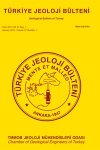
-
2025
-
2024
-
2023
-
2022
-
2021
-
2020
-
2019
-
2018
-
2017
-
2016
-
2015
- 2014
-
2013
-
2012
-
2011
-
2010
-
2009
-
2008
-
2007
-
2006
-
2005
-
2004
-
2003
-
2002
-
2001
-
2000
-
1999
-
1998
-
1997
-
1996
-
1995
-
1994
-
1993
-
1992
-
1991
-
1990
-
1989
-
1988
-
1987
-
1986
-
1985
-
1984
-
1983
-
1982
-
1981
-
1980
-
1979
-
1978
-
1977
-
1976
-
1975
-
1974
-
1973
-
1972
-
1971
-
1970
-
1969
-
1968
-
1966
-
1964
-
1963
-
1961
-
1959
-
1958
-
1955
-
1954
-
1953
-
1952
-
1951
-
1950
-
1949
-
1948
-
1947
Abstract: In this study, it was aimed to determine mineralogical and geochemical properties and differences insources of the deltaic sediments from the area between Deliçay and Tarsus rivers (Mersin). A total of120 samples were taken from 40 different locations and from three different depth intervals to determinemineralogical characteristics of the soils from the study area. Furthermore, a total of 208 samples weretaken for determination of textural and geochemical properties of the topsoils (0-15 cm). Mineralogicalcomposition of soil samples were determined with XRD method, followed by determination of texturaland geochemical properties with Bouyoucos hydrometer and ICP-MS methods, respectively. All the dataobtained in this study were compiled in a Geographic Information System (GIS) database for preparationof various thematic map layers. Furthermore, scatter plots were also used to explore the relationshipbetween the elements such as Ni, Cr, Co, and Fe. The results obtained from thematic map layers and scatterplots suggest that deltaic sediments in the study area originated from two different sources that differin mineralogical and geochemical characters. According to mineralogical and geochemical differencesin these sources, Quaternary sediments in the study area can be divided in two separate parts, suchas western and eastern soils. This differentiation is caused by the geological materials brought fromdifferent sources by the Deliçay and Tarsus rivers, which also played important roles in the formation ofQuaternary sediments. Quaternary sediments in the study area display differences in textural properties inthe north-south direction, whereas showing differences only in geochemical and mineralogical propertiesin the west-east direction.
Abstract: Natural stones qualified as geological heritage are various and also plenty in Turkey, based on its complexgeological framework. Some unique stones have been used in Anatolia since antic times, particularlyfor large and prestigious buildings. Most of the natural stones are typical geoheritages of the country.However they have been no documented at international level, yet. In addition, economic and scientificterminology on the Turkish natural stones are completely different and people do not have correctgeological knowledge about them. In this study, to be able to take attention of earth scientists to thesubject, the roles of natural stones in cultural geology (or the geological fundamentals of natural stoneculture) have been discussed providing brief information about the unique building materials Ahlat Stone,Ankara Stone, Nevşehir Stone Sille Stone and Lületaşı (meerschaum), Pileki Stone, Oltu Stone as rawmaterials for local handcrafts
Abstract: Paleoseismology is an active tectonic discipline that tries to obtain information about the location, time andmagnitude of paleoearthquakes by using geological and geomorphological data. Paleoseismic trenchingis the most important method that is frequently used in paleoseismology and provides considerable data.One of the most important problems encountered especially in deep and benched paleoseismologicaltrench works is the visual representation of the trench stratigraphy and structure to the reader.In this paper, Paleoseismological Three Dimensional Virtual Photography Method, a new photographicmethod for paleoseismology, is presented with a case study. Paleoseismological Three Dimensional VirtualPhotography Method consists of four stages which are respectively: planning, photographing, stitchingand constraction of virtual tour.Paleoseismological Three Dimensional Virtual Photography Method has been applied for the first timeduring the paleoseismological studies carried out on the Tuz Gölü Fault Zone (Central Anatolia, Turkey).The Tuz Gölü Fault Zone (TGFZ) is one of the most important intra-continental active fault zones in theCentral Anatolian Region. TGFZ is an approximately 200 km-long, NW-SE trending, active normal faultzone with a right lateral strike-slip component. The Akhisar-Kılıç segment is one of the most importantsegments of TGFZ which is composed of fault segments parallel or sub-parallel to each other and withlengths varying between 9 and 33 km. In this study, a paleoseismic trench (Duru-2011) has been excavatedon the middle section of Akhisar-Kılıç segment.As a result of the evaluation carried out making use of paleoseismological criteria such as trenchmicrostratigraphy, geometry of fault colluvial wedge, upward termination of fault strands, and 14C agedata, three paleoseismic events were described within the Duru-2011, which occurred in the last 23 000years. On the other hand, in the last 10 500 years two paleoseismic events has been described within theanother paleoseismological study. Earthquake data collected from the two trenches on the same segmentwere evaluated by fault window method. And averagely earthquake recurrence period of Akhisar-Kılıçsegment was calculated as 10390 year. Short time (Late Pleistocene - Recent) annual vertical slip rate ofAkhisar-Kılıç segment was calculated as 0,034 mm/year. This value is well consistent with long term (LatePliocene) vertical geological slip rate (0,046 mm-year) of segment.
View as PDF
Abstract: The presences of base-cover separation are established as all Pontid Tectonic Belt whenstratigraphic units are investigated in the studied area that is located at the northwest of Tokat city. UpperMesozoic cover units are one of cover units located uncormably on base units and are interesting in termsof fossil content and diversity. In this study, these units are dated as detail and stratigraphy of region isconstructed according to these ages. In addition, data of the geologic and stratigraphic positions of studyarea are observed.

 TMMOB
TMMOB